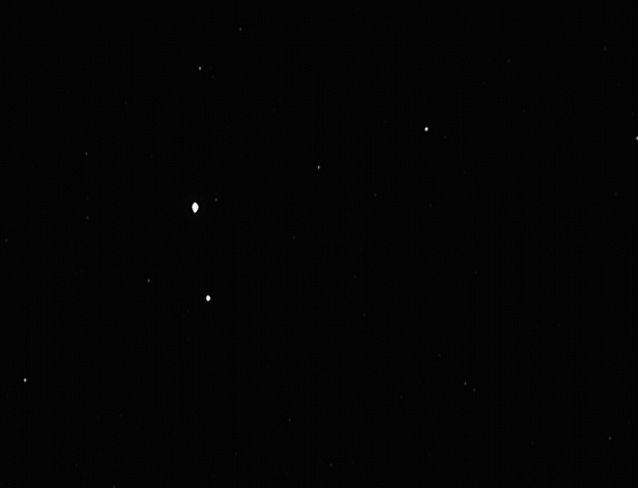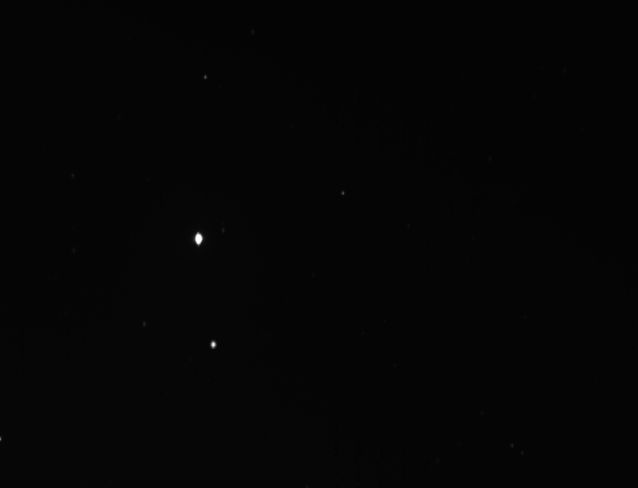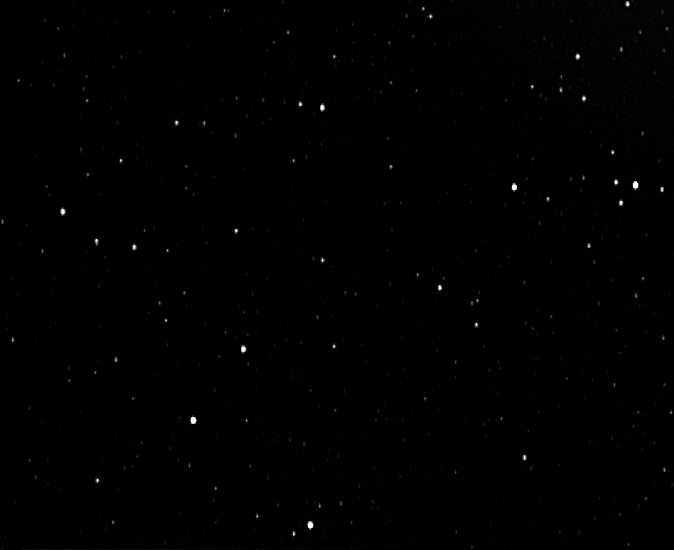

Vesta is asteroid number 4. It was discovered by Heinrich Olbers* on 29th March 1807. It is the brightest of the asteroids (here magnitude 6.6) with an albedo of 0.42 and has a spectrum unique among the larger asteroids. It is the second largest at 578×560×458 km and weighs 2.67× Kg (density 3.42) and has a rotation period of 5.43 hours. It reached opposition on 18 February 2010 when it passed between 40- and 41-Leonis.
Kg (density 3.42) and has a rotation period of 5.43 hours. It reached opposition on 18 February 2010 when it passed between 40- and 41-Leonis.
*Also known for the Olbers' paradox.
Vesta is an interesting object, currently just failing to qualify as a dwarf planet, it is large enough to be differentiated, that is it has a dense core surrounded by a lighter mantle and its surface appears from its spectrum to be pyroxene, a normal constituent of lava. Vesta is distinguished by an enormous impact crater at its south pole which is 460 km in diameter. Images from the Hubble space telescope have yielded spectral data of the inner parts of Vesta. A meteorite which landed in Australia in October 1960 is believed to have come from Vesta, ejected by the impact that formed this crater.

|
Move your mouse over the image to see the major stars identified. I have also added the full Moon to this image to give an indication of the scale. I had hoped to image Vesta as it passed between 40- and 41-Leonis but the clouds decided otherwise. You can see how far Vesta had moved in 2 days. Unfortunately I was unable to continue making images for several hours to see if I could detect this movement, but as soon as conditions permit, I shall image this region again and hopefully this "star" will have disappeared. Date and Time: 20th February 2010 22:55 UT Camera : Starlight Xpress MX716 Telescope: 135 mm SLR lens Capture: Star_mx7: 20" exposure Processing: Star_mx7. Background, non-linear stretch, background. K3CCDTools. 26 frames stacked, unsharp mask 3, 0, 100. |

|
Now you see it; now you don't. The picture on the left was taken, of the same area of the sky, nine days later on 1st March 2010. You can see that a "star" has disappeared. If you move your mouse over the picture, you will see a simulation of a blink-comparator view of this picture and the one above. The second picture was taken through thin cloud, and I have not been able to remove the slight background haze, which becomes obvious in the comparison. Date and Time: 1st March 2010 21:20 UT Camera : Starlight Xpress MX716 Telescope: 135 mm SLR lens Capture: Star_mx7: 20" exposure Processing: Star_mx7. Background, non-linear stretch, background. K3CCDTools. 11 frames stacked. |
 Vesta had moved to this area of sky by the 1st March and I managed to locate it and get a second picture the following night, despite the fact that the conditions were even worse than they had been the night before. Indeed it wasn't until the Moon rose a little later that I realised just how thick the clouds were (I could barely make out the maria with the naked eye). Had I realised, I probably would not even have tried, but it does show that you can get pictures even in the most unpromising of conditions but you can see how the background is light and the fainter stars have disappeared. I got another picture two days later when conditions were very much better. I have not labelled the other stars in the picture. The bright star just above Vesta is, I believe, HIP 49585, HD87718, SAO 81191, at magnitude 8.7. When looking up asteroids in planetarium programs it is necessary to ensure that you have the most up-to-date data because the orbits of the asteroids are not completely stable, and quite considerable errors can result from using old data. Latest data can be obtained from the Minor Planet Center.
Vesta had moved to this area of sky by the 1st March and I managed to locate it and get a second picture the following night, despite the fact that the conditions were even worse than they had been the night before. Indeed it wasn't until the Moon rose a little later that I realised just how thick the clouds were (I could barely make out the maria with the naked eye). Had I realised, I probably would not even have tried, but it does show that you can get pictures even in the most unpromising of conditions but you can see how the background is light and the fainter stars have disappeared. I got another picture two days later when conditions were very much better. I have not labelled the other stars in the picture. The bright star just above Vesta is, I believe, HIP 49585, HD87718, SAO 81191, at magnitude 8.7. When looking up asteroids in planetarium programs it is necessary to ensure that you have the most up-to-date data because the orbits of the asteroids are not completely stable, and quite considerable errors can result from using old data. Latest data can be obtained from the Minor Planet Center.
I used the picture taken on 4th March to calculate the position of Vesta. I made it RA 10h04m17.7s Dec +21°31'38". Downloading the very latest data from the Minor Planet Center into Cartes du Ceil, it gave me the position as RA 10h04m17.4s Dec +21°31'16". I am amazed at how close the agreement is considering that the scale of my picture is about 10 arc-sec per pixel.
Date and Time: 1st, 2nd, and 4th March 2010 23:00, 21:30 and 23:50 UT
Camera : Starlight Xpress MX716
Telescope: 135 mm SLR lens
Capture: Star_mx7: 20" exposure
Processing: Star_mx7. Background, non-linear stretch, background.
RegiStax5. 27, 12 and 11 frames stacked and some adjustment of the histogram.
Home Back to This and That Back to Asteroids